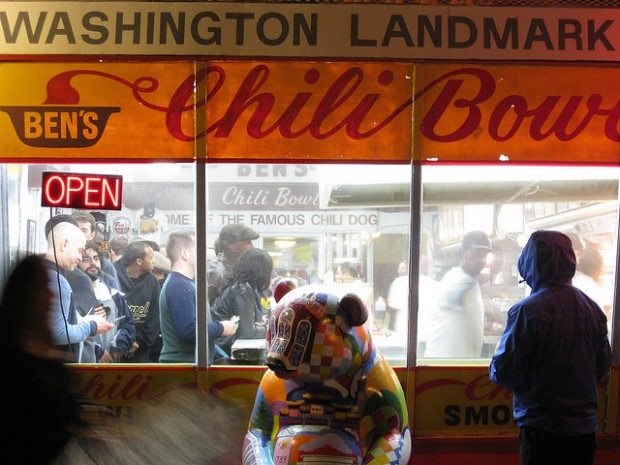If you needed further evidence of D.C.’s rising housing prices, here’s an example: the price tag on the city’s most expensive condo is $7.78 million, which is $2 million more than last year’s most expensive condo sale. Both condos are located in Georgetown.
Author Archives: Elahe Izadi
‘DC Or Nothing’ Trends Worldwide
“DC Or Nothing,” the title of a track from District rapper Wale’s latest album, “Ambition,” was trending worldwide on Twitter early today. The song criticizes leadership in D.C. and lyrics reference a number of District issues, including gentrification and demographic changes; “when the city was chocolate, there was death in the air” and “push them whites in the hood” are some such lines.
The song can be heard here (and, fair warning, it does contain profanity). If you do happen to listen to it, we’d like to know what you think: does Wale accurately describe D.C. with this song?
Richest Congressmen Get Richer
Some Americans are so frustrated with amount of wealth concentrated in the top tier of society that they’ve been protesting for weeks as part of the Occupy protest movement. The Occupy DC protests have called particular attention to the influence money has in politics. So add this to their frustrations: the nation’s richest lawmakers have gotten richer in recent years. Roll Call found that the net worth of all members of Congress was $2 billion in 2010, which is about 25 percent more than the 2008 total.
Ben’s Chili Bowl Owners Buy Longtime H Street Shop
H Street clothing shop George’s Place, Ltd. will soon be replaced after 43 years of business. Nizam and Kamal Ali of Ben’s Chili Bowl reportedly bought the property at 10th and H Streets, NE for $900,000. The Alis aren’t set on opening another Ben’s, though; they’re conducting market research to see “what concept might best fit the neighborhood,” Washington City Paper reports.
Back in September, we profiled George’s Place owner George Butler as he was readying to sell his property after decades on H Street. He reflected upon his time on the now gentrifying corridor, and he said he felt there was little impetus to keep longtime, black-owned businesses afloat.
Ben’s is a rarity in D.C.; it’s been on U Street since before the 1968 riots, and has not only survived but thrived as that corridor experienced revitalization. Ben’s has expanded its half-smoke empire in recent years with the opening of a location at Nationals Park and Ben’s Next Door on U Street. The Alis have strong roots in the District; so if they’re the ones to buy up a longtime H Street shop to open a restaurant, should it be called gentrification? If not, then what is it?
Congressmen Receive Food Stamps
How difficult is it to have a nutritious diet while on food stamps? It’s “impossible,” according to D.C.’s nonvoting member in Congress, Del. Eleanor Holmes Norton. She and other Democratic lawmakers took part in the National Food Stamp Challenge organized by religious groups. The objective of the challenge: to demonstrate what life is like for those living off food stamps. The congressmen have $31.50 a week to spend on groceries.
Food stamp usage around the country has risen, and D.C. is no exception; 13 percent more District residents received food stamps this year compared to 2010. About a quarter of the city’s population, 140,295 people, is now on food stamps.
Cupcakes and Bulletproof Glass
Nothing says neighborhood change and gentrification like a cupcake shop. But what if such a shop has bulletproof glass inside? The Washington City Paper reports that the first cupcake shop east of the Anacostia River, Olivia’s Cupcakes, has a “thick sheet” of bullet-resistant glass behind the counter:
“It broke my heart to do that, but it’s a deterrent,” says proprietor Cindy Bullock, who runs the cupcake shop alongside her husband, Bob Bullock, and their daughters, Kristina, 20, and Alexis, 18.
“Several people asked (about the glass) and said, ‘It’s a beautiful shop, its unfortunate that you have it up,’ but we had to have it,” Bullock says.
“I have owned several business in this area and we have been robbed several times,” she explains. “We wanted to make [the shop] elegant and beautiful, but because of the teenagers and having my children here we wanted to protect them.”
D.C.’s bullet resistant glass initially appeared in stores in the wake of the 1968 riots, and became much more widespread at the height of the crack epidemic. Like the Bullocks, many store owners have installed glass after bad experiences.
In gentrifying neighborhoods, the glass barricade coming down is a turning point. It’s also sometimes necessary to appeal to a wealthier clientele. Take Logan Circle, where most liquor and convenience stores had the glass for decades. Then Whole Foods opened on P Street, NW in 2000. Property values rose, and Amare Lucas, owner of Best-In Liquors on P and 15th streets NW decided to take down his glass. The more inviting atmosphere, along with new stock he brought in, attracted more customers, new and longtime residents alike. “Some [customers] told me they had been in the neighborhood for 15 years, kind of passing the store by because of the glass,” Lucas told Washington City Paper‘s Dave Jamieson in 2005. “They’re in my store now. It really gives you a satisfaction.”
‘We’re a Culture, Not a Costume:’ Racist Halloween Costumes?
Halloween is finally here, and if you plan to dress as a “Mexican” tonight, you may want to reconsider it. That’s according to a group of Ohio University students, who started the “We’re a culture, not a costume” campaign last week to raise awareness of what they deem to be offensive costumes.
The students are members of the group S.T.A.R.S., and their treasurer Stephanie Sheeley spoke with Colorlines’ reporter Jorge Rivas about some of the criticisms of the campaign. Sheeley told Rivas that its offensive to wear a costume that’s meant to represent a marginalized group rather than dress up as an individual person who happens to be of another ethnicity:
Many of you had a lot to say about the campaign when we wrote about it last week. We also polled readers as to whether it’s racist to dress up in a costume that’s meant to represent an entire race (you can still cast your vote). Most people who responded didn’t have much problem with such costumes:
Longtime Bloomingdale Art Gallery Owner On Gentrification
The Washington Informer profiles NOA Gallery in Bloomingdale, which Michael Little started in 1970s. For decades, the majority of the neighborhood and Little’s customers were black and he sold many works that could be seen on the sets of black television programs.
‘Shakespeare is the 99 percent’
The film “Anonymous” is based on the premise that Shakespeare’s works were in fact written by a member of the aristocracy. One D.C. teacher takes issue with a group distributing curriculum materials that back the film’s theory.
Digging into the Effects of D.C.’s Rising Housing Values
Housing values in the District are continuing to rise. As redevelopment spreads throughout the city, American Observer‘s Paul Abowd ponders who can afford to stay in D.C.










